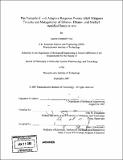| dc.contributor.advisor | John M. Essigmann. | en_US |
| dc.contributor.author | Frick, Lauren Elizabeth | en_US |
| dc.contributor.other | Massachusetts Institute of Technology. Biological Engineering Division. | en_US |
| dc.date.accessioned | 2009-01-23T14:57:36Z | |
| dc.date.available | 2009-01-23T14:57:36Z | |
| dc.date.copyright | 2007 | en_US |
| dc.date.issued | 2007 | en_US |
| dc.identifier.uri | http://dspace.mit.edu/handle/1721.1/42382 | en_US |
| dc.identifier.uri | http://hdl.handle.net/1721.1/42382 | |
| dc.description | Thesis (Ph. D.)--Massachusetts Institute of Technology, Biological Engineering Division, 2007. | en_US |
| dc.description | Vita. | en_US |
| dc.description | Includes bibliographical references. | en_US |
| dc.description.abstract | The Escherichia coli AlkB protein is an exceptionally versatile DNA repair enzyme. Its expression is induced upon exposure to alkylating agents as part of the Ada-mediated adaptive response. This member of the ac-ketoglutarate/iron(II)-dependent dioxygenase family was originally discovered to reverse directly methylated lesions formed preferentially in single-stranded regions of DNA, such as 1-methyladenine and 3- methylcytosine. Repair proceeds via an oxidative demethylation pathway, in which the aberrant methyl group is hydroxylated and spontaneously lost as formaldehyde. Since these early studies, the list of lesions repaired by AlkB through this pathway has been extended to include 1-methylguanine, 3-methylthymine, 3-ethylcytosine, and 1-ethyladenine. Furthermore, the protein possesses a second, distinct chemical mechanism through which it can repair another class of lesions, the etheno-adducts formed by the reaction of DNA with metabolites of the carcinogen vinyl chloride or with breakdown products generated by lipid oxidation. In this case, direct repair proceeds through epoxidation of the etheno bond, creating an intermediate that hydrolyzes to a glycol form and finally releases the two-carbon bridge as glyoxal, restoring the unadducted adenine or cytosine. Thus, the AlkB protein bridges the repair of alkylative lesions with those induced by oxidative stress and embodies the multi-faceted protection required to preserve genomic stability and coding information despite the constant threats to which organisms are exposed. | en_US |
| dc.description.abstract | (cont.) Herein, we exploit and characterize a pair of E. coli strains differing only in AlkB status to demonstrate the ability of AlkB to repair the etheno-lesions, the structural analog 1,N6-ethanoadenine (EA), and 3-methyluracil in vivo. Additionally, we establish the ability of the EA "repair product" to form interstrand cross-links in certain sequence contexts of duplex DNA. We also show that although the adaptive response proteins repair lesions generated by oxidative stress, oxidative agents do not induce expression of the response. Finally, we establish that certain hypothesized substrates for AlkB are not in fact repaired by the enzyme, nor are they repaired by another adaptive response protein, AidB. This work extends the current knowledge regarding the amazing ability of AlkB to protect cellular nucleic acids from damage arising from a diverse array of both endogenous and exogenous sources. | en_US |
| dc.description.statementofresponsibility | by Lauren Elizabeth Frick. | en_US |
| dc.format.extent | 258 p. | en_US |
| dc.language.iso | eng | en_US |
| dc.publisher | Massachusetts Institute of Technology | en_US |
| dc.rights | MIT theses are protected by copyright. They may be viewed, downloaded, or printed from this source but further reproduction or distribution in any format is prohibited without written permission. | en_US |
| dc.rights.uri | http://dspace.mit.edu/handle/1721.1/42382 | en_US |
| dc.rights.uri | http://dspace.mit.edu/handle/1721.1/7582 | en_US |
| dc.subject | Biological Engineering Division. | en_US |
| dc.title | The versatile E. coli adaptive response protein AlkB mitigates toxicity and mutagenicity of etheno-, ethano-, and methyl-modified bases in vivo | en_US |
| dc.title.alternative | Versatile Escherichia coli adaptive response protein AlkB mitigates toxicity and mutagenicity of etheno-, ethano-, and methyl- modified bases in vivo | en_US |
| dc.type | Thesis | en_US |
| dc.description.degree | Ph.D. | en_US |
| dc.contributor.department | Massachusetts Institute of Technology. Department of Biological Engineering | |
| dc.identifier.oclc | 234446098 | en_US |
